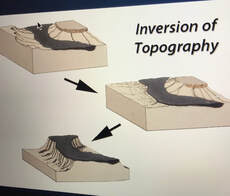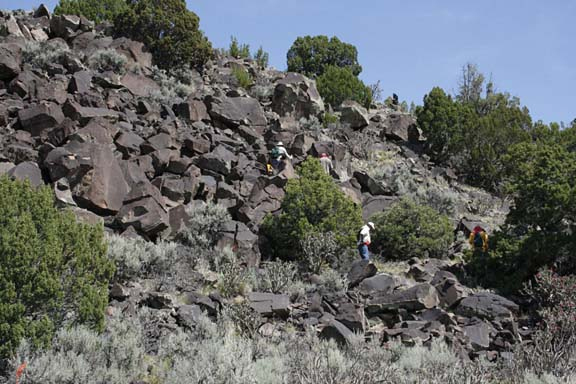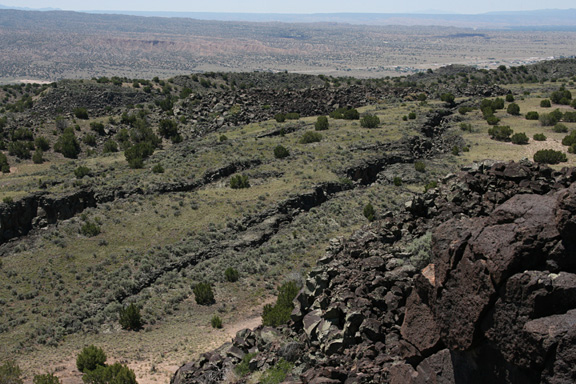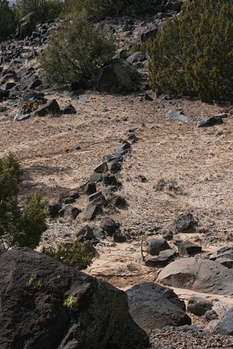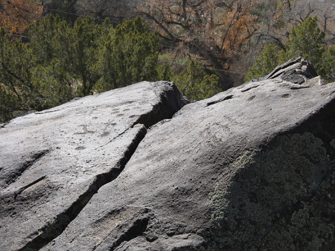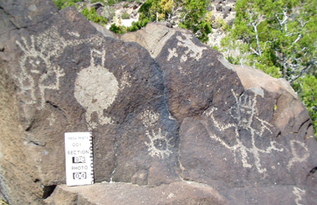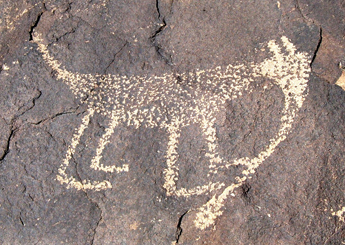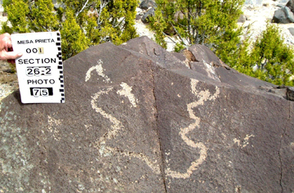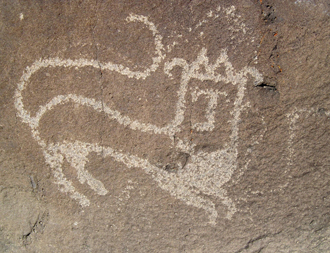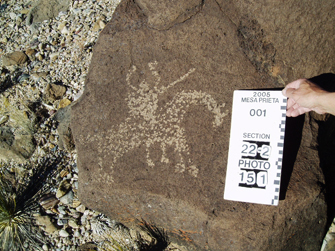Mesa Prieta - The Place
Geology
About 3.3 million years ago, a fissure near Pilar vented molten lava which flowed about 25 miles south on top of the river-cobble and sand which forms the Santa Fe Group, a sedimentary deposition comprising eroded material from the Sangre de Cristo Mountains. When the hot lava cooled, it formed a hard canoe-shaped basalt layer. As the Rio Grande began to flow about 440,000 years ago, it eroded the softer landscape around the basalt layer, eventually leaving the protected mesa cap towering one thousand feet above the river basin, as it is today.
Basalt boulders have a light brown color when newly formed or when continuously covered with soil. Erosional processes that expose the boulders to light, moisture and air cause a dark patina or "desert varnish" to develop on the surface of the boulders. New fractures, boulders becoming uncovered, and the process of creating petroglyphs on the boulders break through the dark patina, exposing the natural lighter color below.
Significance
|
The terrain on Mesa Prieta is
|
Deep fissures and rugged escarpments
|
Archaeologists note that there are numerous other archaeological features, such as shrines, water control systems, check dams, lithic scatters, ceramics, field houses and other structures, grid gardens and ancient and historic trails in addition to the rock images. The number and quality of the glyphs make the mesa similar in importance to other major sites in New Mexico such as Petroglyph National Monument in Albuquerque and |
the Three Rivers site near Tularosa. Approximately 80% of the glyphs and other features are on private land. Most of the remaining 20% are located on Bureau of Land Management land with The Archaeological Conservancy owning 181 acres and Ohkay Owingeh a small amount.
While the mesa's more remote location has spared it the problems of Petroglyph National Monument, there are troubling issues. Development is encroaching in some areas. Some important petroglyph sites have been mined for riprap. Mining continues today and the threat of future mining is always present. Vandalism has been less extensive than at some sites, but is evident in the most visited sections. One of the worst hazards is destruction caused by off-road vehicle traffic in areas with concentrations of glyphs, particularly on BLM land. Some areas of concentrated glyphs on steep slopes have been seriously eroded by centuries of overgrazing by sheep and torrential monsoon rains in the overgrazed areas. With increased visitation to the petroglyph areas, escalation of erosion has been observed, particularly in areas where visitors do not stay on established trails.
Mesa Prieta Petroglyph Styles |
Prehistoric agricultural check dam. Agricultural features constructed of rocks are common on the mesa; recording volunteers record these structures as Cultural Landscape features. |
The rock images found on Mesa Prieta represent three distinct time periods: Archaic, Pueblo IV, and Post European Contact (Historic) including Modern. All three types are well represented, which makes the site unique and testifies to intense human occupation in the surrounding areas over the past several thousand years. Folsom points have been found which confirm about ten thousand years of human activity in the area. The availability of water nearby has made Mesa Prieta a compelling locale for humans and its huge, dark boulders are ideal for rock graphics.
Archaic Period
Ancient Archaic Period Petroglyph. These petroglyphs are so heavily repatinated that they are often difficult to see.Boulder showing cupules and a one-poled ladder from the Archaic period. Cupules are archaeological features found worldwide and are thought to have ceremonial purposes. |
Archaic period images are scattered around the site. They have much in common with archaic glyphs found around the world. Though exact dates are not verifiable at this time, the images can be related to Archaic era glyphs found in the Glorieta area of New Mexico that were associated with wood samples that have been carbon dated to about 5,000 years ago.
|
Ancestral Pueblo - Pueblo IV
The largest numbers of petroglyphs on the site are from the Pueblo IV period, roughly 1300 A.D. to 1600 A.D. Perhaps 75% of the petroglyphs on Mesa Prieta fall into this category. These petroglyphs were created by Ancestral Puebloan peoples who filtered into the area around 1300 A. D., probably from the Four Corners region. They developed what has come to be known as the Rio Grande Style. The florescence of rock images reached its peak sometime before the arrival of the Spanish conquistador Juan de Oñate in 1598 who established a crown colony at San Gabriel near Ohkay Owingeh (San Juan Pueblo).
A huge number and variety of glyphs were created during this period. These include circles, spirals, stars, geometric patterns, human hand and foot prints and animal prints such as deer, elk, bear and turkey. Human figures appear as dancers, shamans, hunters, flute players, women giving birth and warriors. Most Pueblo IV glyphs are believed by archaeologists to be related to some form of ritual or ceremony.
The flute player is a common image in Ancestral Puebloan rock images. Animal flute players are unusual; the largest concentration of these images occurs on the Wells Petroglyph Preserve.
This image shows both one-horned and two-horned serpents emerging from a crack in the boulder. Serpents in Ancestral Pueblo images
|
This Ancestral Puebloan petroglyph shows several ceremonial figures including a shield bearer, a shamanistic figure with a two-horned serpent across his body and a large-headed figure with a headdress. A possible mountain lion or canine is at the top. Snake images abound on the mesa. One of the most common types is the two-horned Awanyu. The Awanyu is a Tewa diety, the guardian of water, either free flowing as in a river or zig-zag as in lightning. The depiction of Awanyu in petroglyphs is a common motif. One-horn Awanyus in profile with the horn facing backward are less common. Other snake images appear to have rattles on their tails or to have the appearance of lightning.
|
Post European Contact (Historic) Period
The third major time period for petroglyphs on the mesa is the Historic era which began around 1600 A.D with the coming of the Spanish. The most common image is the Christian cross. Sheepherders and others created hundreds of examples. Less common but significant are the many images of horses and horses with riders.
A unique feature on the mesa is that of Spanish lion images; several have been found and some are magnificently done. Other Historic images include wagons, inscriptions, dates, names, initials, churches and humans. |
This rider on a horse appears to be holding a spear. We know, by the subject matter, that this petroglyph was made after 1600 as the Puebloan people did not have horses prior to the arrival of the Spanish.
|

